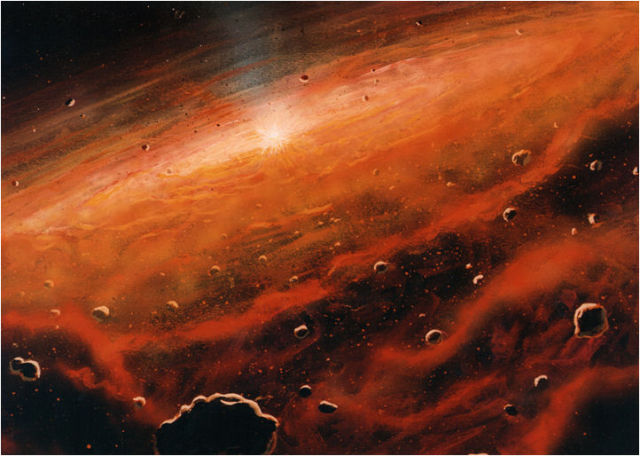The quantum nature of the proton can crucially affect the structural and physical properties of hydrogen compounds. For example, in the high-pressure phases of H2O, quantum proton fluctuations lead to symmetrization of the hydrogen bond and reduce the boundary between asymmetric and symmetric structures in the phase diagram by 30 gigapascals (ref. 3). Here we show that an analogous quantum symmetrization occurs in the recently...
Tag Archives: System
Dengue virus disables the immune system by blocking mass transit

A virus in the same family as Dengue. (credit: Oak Ridge National Lab)
The Dengue virus comes in four distinct but related varieties called serotypes, and they're all bad. Rather than inducing tolerance for each other, infection with one Dengue serotype actually makes people more sensitive to the other three. Victims infected by a second serotype...
How old rocks tell us new things about Solar System formation

(credit: NASA)
The most common rocks that fall to Earth are called chondritic meteorites, or chondrites. In fact, the Earth is probably made of them. These are some of the oldest rocks in the Solar System, some dating to its very origin at just over four and a half billion years old. And some of their internal...
How Amazon inspired a drone delivery system for birth control in Ghana

When U.N. health experts were trying to come up with a way to deliver contraceptives to women in hard-to-reach areas of Ghana, they took a page from Amazon’s drone delivery playbook. Their pilot project, known as Dr. One, was reportedly inspired in late 2014 by the Seattle-based online retailer’s...
VRstudios ships wireless virtual reality system to aerospace, construction, architecture customers

VRstudios reached a milestone today as the Bellevue-based startup began shipping its virtual reality systems to business customers around the world. The company, previously in stealth mode, has developed a wireless, full-motion virtual reality hardware/software solution that allows...
Dragon Drive is the best car voice activation system we’ve spoken to
Brian Ratliff from Nuance gives us a demo of Dragon Drive, the voice activation system in the new BMW 7 Series. Video shot/edited by Jennifer Hahn (video link)
LAS VEGAS—Distracted driving is a real problem. Even though most of us intrinsically know that playing with our phones isn't compatible with piloting a vehicle surrounded by other vehicles and pedestrians, it's a common enough problem that...
Ready for the ‘Really Big One’? Congress boosts quake warning system

The omnibus spending bill that was approved by Congress today includes another $ 8.2 million for a quake-monitoring system that could provide early warning if we’re hit by “the Really Big One” that everyone’s been freaked out about. Sen. Patty Murray...
Ammoniated phyllosilicates with a likely outer Solar System origin on (1) Ceres
Studies of the dwarf planet (1) Ceres using ground-based and orbiting telescopes have concluded that its closest meteoritic analogues are the volatile-rich CI and CM carbonaceous chondrites. Water in clay minerals, ammoniated phyllosilicates, or a mixture of Mg(OH)2 (brucite), Mg2CO3 and iron-rich serpentine have all been proposed to exist on the surface. In particular, brucite has been suggested from analysis of the mid-infrared spectrum...
Ammoniated phyllosilicates with a likely outer Solar System origin on (1) Ceres
Studies of the dwarf planet (1) Ceres using ground-based and orbiting telescopes have concluded that its closest meteoritic analogues are the volatile-rich CI and CM carbonaceous chondrites. Water in clay minerals, ammoniated phyllosilicates, or a mixture of Mg(OH)2 (brucite), Mg2CO3 and iron-rich serpentine have all been proposed to exist on the surface. In particular, brucite has been suggested from analysis of the mid-infrared spectrum...
Measuring entanglement entropy in a quantum many-body system
Entanglement is one of the most intriguing features of quantum mechanics. It describes non-local correlations between quantum objects, and is at the heart of quantum information sciences. Entanglement is now being studied in diverse fields ranging from condensed matter to quantum gravity. However, measuring entanglement remains a challenge. This is especially so in systems of interacting delocalized particles, for which a direct experimental measurement...


